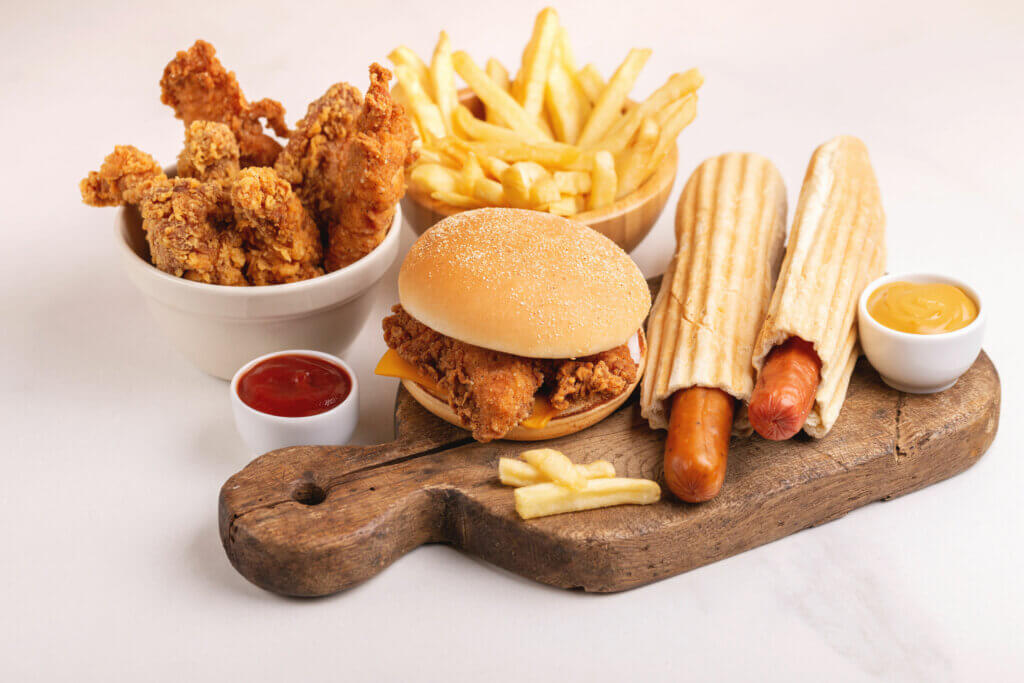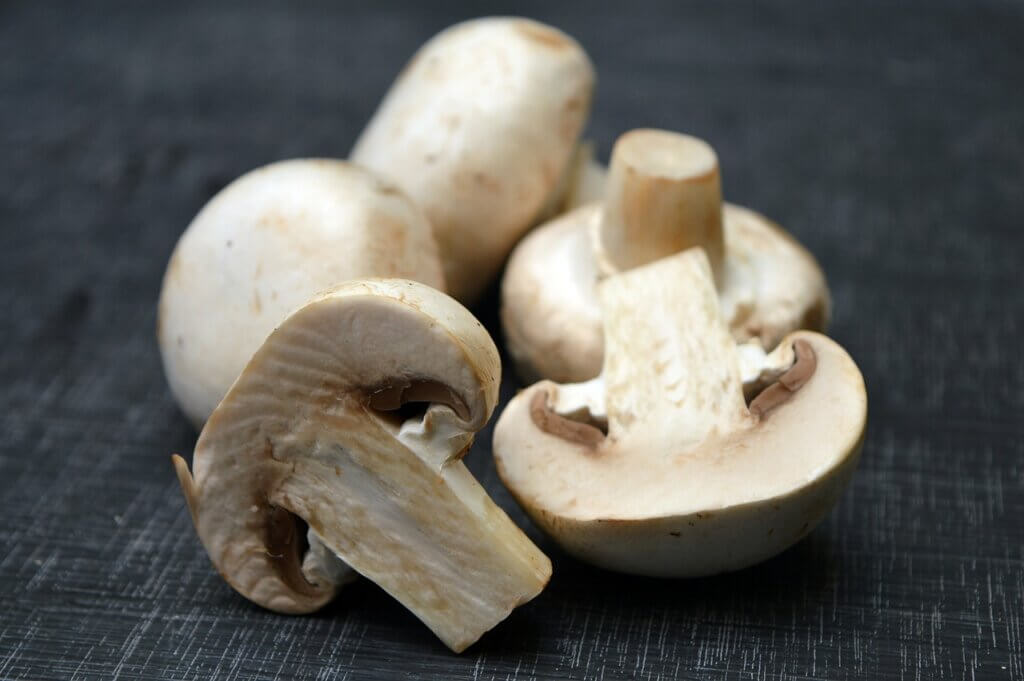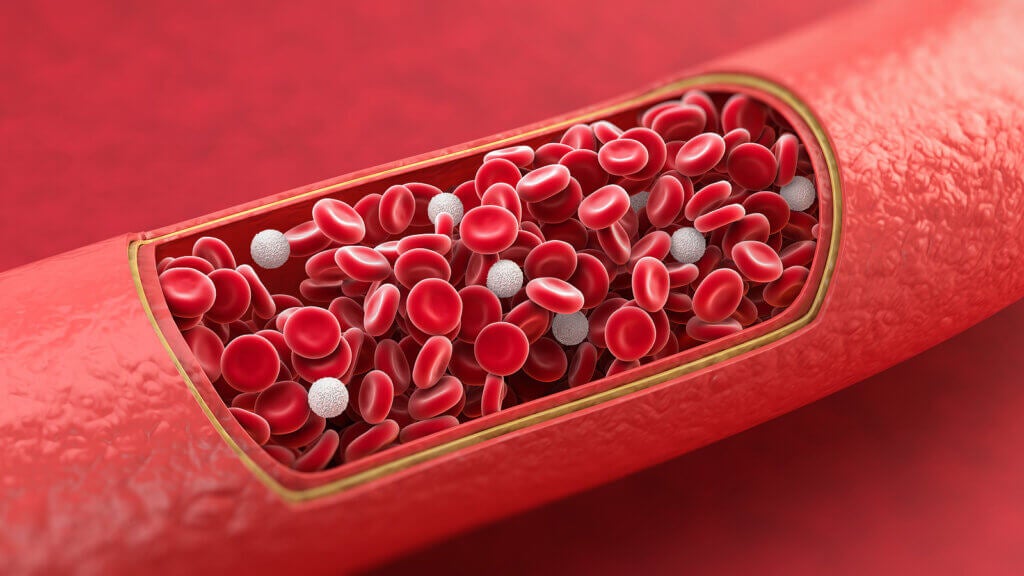The 15 Most Dangerous Foods for Your Health


Escrito y verificado por el nutricionista Saúl Sánchez
There are a number of foods that are dangerous to health. This is due to the presence of substances that can alter the physiology of the body.
There are even certain products that can be harmful due to their microbiological risk. These foods can develop microorganisms that colonize the digestive tract, causing poisoning.
The most dangerous foods for health
We’re going to tell you which are the 15 most dangerous foods for your health so that you avoid including them regularly in your diet. Nothing will happen to consume them one day in isolation, but it’s essential that this doesn’t become a habit.
1. Industrial chocolates
The main industrial chocolate brands produce a food that stands out for its concentration of simple and added sugars. These compounds are capable of increasing the risk of developing complex and metabolic diseases, according to a study published in the British Medical Bulletin journal.
They significantly affect blood glucose levels, causing pancreatic stress that leads to inflammation. Insulin resistance gradually develops, the precursor to type 2 diabetes.
Despite the fact that cocoa is a plant-based ingredient with health benefits, most of the chocolates that are for sale contain only a small amount of it. They mainly contain sugar and hydrogenated fats, both of which are harmful elements.
When choosing a chocolate, it’s best to opt for one that has a large dose of cocoa inside, meaning it will have few added sugars. You can even opt for varieties lacking sugar as an ingredient altogether.
2. Sugary soft drinks
Sugary sodas also have too many high-glycemic carbohydrates. The effect is even more detrimental than in the previous case, as being dissolved in a liquid, absorption is faster. According to research published in the journal Current Diabetes Reports, the regular intake of these products in children leads to obesity and diabetes.
Also, most sugary sodas have food additives. Some of these compounds are negative for health. Among the most dangerous are preservatives and artificial sweeteners.
Sodas with no added sugar aren’t a good option either. These provide fewer calories but contain more additives. Their intake could be just as harmful to metabolism.
3. Industrial pastries
Although industrial pastries may contain lower amounts of sugar than other ultra-processed ones, they have trans fats that are inflammatory in nature. These are generated from the hydrogenation of lipids found in nature. They can also be formed from the subjecting of fats to aggressive thermal processes.
The truth is that the regular presence of these elements in the diet causes a greater risk of suffering from diseases such as diabetes and cardiovascular diseases. This is evidenced by a study published in the journal Diabetes & Metabolic Syndrome. Trans fatty acids are capable of influencing the lipid profile and inflammatory mechanisms in the body.
4. Sausages and lunch meats: Ultra-processed foods that are dangerous for health
There are several types of sausages and lunch meats. Some of them can be included in a healthy diet without causing too many problems. Among them are the Serrano ham and turkey breast.
However, most of those that can be found on the market fall into the category of processed meats, which are harmful to the body. They have poor-quality animal parts and contain additives.
Among the latter compounds, special mention must be made of preservatives, especially nitrites. They’re capable of increasing the useful life of meats but at the cost of causing damage to human health. There’s evidence that their continued use could increase the risk of developing colorectal cancer.

5. Raw fish
Raw fish can be a delicacy. However, to consume it without risks, it needs to be very fresh and have been subjected to a series of previous processes. This ensures the absence of pathogenic microorganisms.
However, not all fish can be eaten raw. For example, those varieties likely to contain anisakis must first go through a freezing process to inactivate the parasite. This process can even trigger a reaction if an allergy is experienced.
At the same time, it’s essential to avoid eating raw fish in restaurants that aren’t trusted. A mistake when consuming these types of products can lead to food poisoning.
6. Fast food chain burgers
Homemade hamburgers can be a meal of a certain quality. For this, it’s important to know what type of meat is used, the spices used, and guarantee the absence of additives. However, fast-food establishments don’t adhere to these principles.
It’s common for the worst parts of the animal to be used for the preparation of this type of hamburger. In addition, nitrites and sulphites are added to ensure their correct conservation.
For this reason, you should always avoid going to these kinds of establishments. Besides the poor quality of the meat, we must add the use of sauces with a high amount of trans fatty acids and calories.
7. Industrial sauces: Dangerous foods for health
As we’ve just mentioned, industrial sauces aren’t good for health either. They can cause damage to the body due to the presence of additives or due to the increase in energy value.
There are certain preparations, such as mayonnaise, that may not pose a risk, as long as some food hygiene standards are observed. They’re made from good quality oil and egg, two foods that stand out for their nutritional density. The only danger is that if they’re not kept at a low temperature, this could trigger the proliferation of pathogenic microorganisms.
8. Alcoholic beverages
For many years, it was claimed that responsible alcohol intake could generate benefits for cardiovascular health, especially if what was consumed was wine. At present, we know that this isn’t the case. This substance is toxic regardless of the dose consumed, so the best option is to restrict it in the diet.
Alcohol is capable of increasing cortisol levels in the body. In addition, it adversely affects the functioning of the heart, liver, and kidneys.
As if this weren’t enough, this substance becomes more dangerous when combined with energy drinks with high doses of caffeine. The alkaloid masks the early signs of poisoning, which can lead people to drink more and cause greater damage. This is stated in a study published in the Journal of American College Health.
9. Fried foods
The cooking method used matters. When food is fried, there’s a change in the spatial configuration of fatty acids, which generates an increase in the proportion of trans-type lipids. These, as we’ve already stated, are capable of affecting health by promoting inflammatory mechanisms. Therefore, fried foods are very dangerous for your health.
At the same time, frying implies an increase in the energy value of the product. This effect causes an imbalance in the energy balance in favor of intake
It must be taken into account that the best cooking methods to ensure good health are those that are low in fat and at low temperatures that don’t generate too much aggression. Skillets, cooking with water, steam-cooking, and baking in the oven are good options.

10. Battered foods
We’ve mentioned that frying is bad. But it’s even worse with batter. To the above effects, we must add the presence of a toxin known as acrylamide that’s derived from subjecting carbohydrates to very high temperatures. This element has been linked to an increased risk of developing certain types of cancer, as stated in a study published in the journal Critical Reviews in Food Science and Nutrition.
At the same time, batters are usually made with products that contain significant amounts of high-glycemic carbohydrates, such as flour. These elements are capable of altering blood glucose levels, causing insulin resistance.
11. French fries
French fries have a high energy density, large amounts of trans fats, salt, and additives. In addition, they’re very palatable, so it’s difficult to eat a reasonable amount.
Keep in mind that high doses of salt in the diet aren’t recommended. Although there’s disagreement about the effects of this ingredient on blood pressure, experts say that you may experience an increased risk of high blood pressure.
At the time of eating fried foods, even if it’s only on occasion, it’s always best for them to be made at home. Some aspects related to the preparation process, such as the number of uses of the oil, can influence its final quality.
12. Industrial pizzas
Homemade pizza can be a healthy food. For example, it’s a meal that favors recovery after intense sports effort, as long as the dough has good-quality flour.
However, industrial varieties don’t usually have healthy ingredients. Very refined wheat flour is used for the dough, which has a great impact on blood glucose levels. In turn, the cheeses have a high-fat portion and little protein.
It’s important to differentiate the types of pizza that can be offered in restaurants. Those that are consumed in fast food places have nothing to do with the pizzas that are made in specialized Italian restaurants.
13. Pufferfish
Surely you’ve heard of the dangers associated with consuming pufferfish. This refers to a marine animal is known that bears a certain resemblance to a hedgehog, as it’s capable of swelling and baring a series of quills as a defense mechanism. Although it’s edible, the use of fish liver, which has a deadly toxin, should be avoided in its preparation.
The ingestion of part or remains of the pufferfish liver generates progressive muscular paralysis, which can cause death if an antidote isn’t consumed in time. This food is only offered in specialized restaurants.
However, the benefit doesn’t outweigh the risk. Although from the organoleptic point of view, it’s a highly appreciated fish, it’s better to opt for other varieties that don’t contain such a dangerous toxin. The good news is that pufferfish is rarely offered in Western restaurants.
14. Blood clams: Molluscs that are dangerous to health in the short term
It’s impossible to speak of the most dangerous foods for health without mentioning the case of blood clams. These bivalve animals are named after the color of their meat, due to the concentration of hemoglobin. It’s a product that’s tasty and whose nutritional value is adequate. However, it’s possible that it’s contaminated with different pathogens.
For example, blood clams can transmit hepatitis A, hepatitis E, typhoid fever, and dysentery. For this reason, it’s better to avoid their consumption.
However, special care must be taken when introducing bivalves and mollusks into the diet of people with special situations. Pregnant women or the elderly are especially susceptible to food poisoning.
15. Mushrooms
In the world, there is a great variety of mushrooms. Many of them are commonly consumed and don’t pose any health risks.
However, there are also very toxic classes. For this reason, only those offered in the supermarket should be prepared.
It’s a frequent mistake made by inexperienced people to go to the mountains to collect mushrooms and eat them without the supervision of a professional. It’s possible to confuse the varieties, as they’re often differentiated by features that are hard to recognize for amateurs to identify.

Avoid introducing the most dangerous foods for health into your diet
There are several foods whose consumption can negatively affect human health. For this reason, we recommend avoiding all the products mentioned as much as possible.
The best way to plan a healthy diet is to choose fresh foods and ensure that your diet has variety and balance from the energy point of view. It’s essential to choose suitable cooking methods, avoiding fried foods, batters, and embers.
Finally, we recommend paying special attention to drinks. The best thing to ensure a good state of hydration is water. Avoid soft drinks, juices, and alcoholic beverages.
There are a number of foods that are dangerous to health. This is due to the presence of substances that can alter the physiology of the body.
There are even certain products that can be harmful due to their microbiological risk. These foods can develop microorganisms that colonize the digestive tract, causing poisoning.
The most dangerous foods for health
We’re going to tell you which are the 15 most dangerous foods for your health so that you avoid including them regularly in your diet. Nothing will happen to consume them one day in isolation, but it’s essential that this doesn’t become a habit.
1. Industrial chocolates
The main industrial chocolate brands produce a food that stands out for its concentration of simple and added sugars. These compounds are capable of increasing the risk of developing complex and metabolic diseases, according to a study published in the British Medical Bulletin journal.
They significantly affect blood glucose levels, causing pancreatic stress that leads to inflammation. Insulin resistance gradually develops, the precursor to type 2 diabetes.
Despite the fact that cocoa is a plant-based ingredient with health benefits, most of the chocolates that are for sale contain only a small amount of it. They mainly contain sugar and hydrogenated fats, both of which are harmful elements.
When choosing a chocolate, it’s best to opt for one that has a large dose of cocoa inside, meaning it will have few added sugars. You can even opt for varieties lacking sugar as an ingredient altogether.
2. Sugary soft drinks
Sugary sodas also have too many high-glycemic carbohydrates. The effect is even more detrimental than in the previous case, as being dissolved in a liquid, absorption is faster. According to research published in the journal Current Diabetes Reports, the regular intake of these products in children leads to obesity and diabetes.
Also, most sugary sodas have food additives. Some of these compounds are negative for health. Among the most dangerous are preservatives and artificial sweeteners.
Sodas with no added sugar aren’t a good option either. These provide fewer calories but contain more additives. Their intake could be just as harmful to metabolism.
3. Industrial pastries
Although industrial pastries may contain lower amounts of sugar than other ultra-processed ones, they have trans fats that are inflammatory in nature. These are generated from the hydrogenation of lipids found in nature. They can also be formed from the subjecting of fats to aggressive thermal processes.
The truth is that the regular presence of these elements in the diet causes a greater risk of suffering from diseases such as diabetes and cardiovascular diseases. This is evidenced by a study published in the journal Diabetes & Metabolic Syndrome. Trans fatty acids are capable of influencing the lipid profile and inflammatory mechanisms in the body.
4. Sausages and lunch meats: Ultra-processed foods that are dangerous for health
There are several types of sausages and lunch meats. Some of them can be included in a healthy diet without causing too many problems. Among them are the Serrano ham and turkey breast.
However, most of those that can be found on the market fall into the category of processed meats, which are harmful to the body. They have poor-quality animal parts and contain additives.
Among the latter compounds, special mention must be made of preservatives, especially nitrites. They’re capable of increasing the useful life of meats but at the cost of causing damage to human health. There’s evidence that their continued use could increase the risk of developing colorectal cancer.

5. Raw fish
Raw fish can be a delicacy. However, to consume it without risks, it needs to be very fresh and have been subjected to a series of previous processes. This ensures the absence of pathogenic microorganisms.
However, not all fish can be eaten raw. For example, those varieties likely to contain anisakis must first go through a freezing process to inactivate the parasite. This process can even trigger a reaction if an allergy is experienced.
At the same time, it’s essential to avoid eating raw fish in restaurants that aren’t trusted. A mistake when consuming these types of products can lead to food poisoning.
6. Fast food chain burgers
Homemade hamburgers can be a meal of a certain quality. For this, it’s important to know what type of meat is used, the spices used, and guarantee the absence of additives. However, fast-food establishments don’t adhere to these principles.
It’s common for the worst parts of the animal to be used for the preparation of this type of hamburger. In addition, nitrites and sulphites are added to ensure their correct conservation.
For this reason, you should always avoid going to these kinds of establishments. Besides the poor quality of the meat, we must add the use of sauces with a high amount of trans fatty acids and calories.
7. Industrial sauces: Dangerous foods for health
As we’ve just mentioned, industrial sauces aren’t good for health either. They can cause damage to the body due to the presence of additives or due to the increase in energy value.
There are certain preparations, such as mayonnaise, that may not pose a risk, as long as some food hygiene standards are observed. They’re made from good quality oil and egg, two foods that stand out for their nutritional density. The only danger is that if they’re not kept at a low temperature, this could trigger the proliferation of pathogenic microorganisms.
8. Alcoholic beverages
For many years, it was claimed that responsible alcohol intake could generate benefits for cardiovascular health, especially if what was consumed was wine. At present, we know that this isn’t the case. This substance is toxic regardless of the dose consumed, so the best option is to restrict it in the diet.
Alcohol is capable of increasing cortisol levels in the body. In addition, it adversely affects the functioning of the heart, liver, and kidneys.
As if this weren’t enough, this substance becomes more dangerous when combined with energy drinks with high doses of caffeine. The alkaloid masks the early signs of poisoning, which can lead people to drink more and cause greater damage. This is stated in a study published in the Journal of American College Health.
9. Fried foods
The cooking method used matters. When food is fried, there’s a change in the spatial configuration of fatty acids, which generates an increase in the proportion of trans-type lipids. These, as we’ve already stated, are capable of affecting health by promoting inflammatory mechanisms. Therefore, fried foods are very dangerous for your health.
At the same time, frying implies an increase in the energy value of the product. This effect causes an imbalance in the energy balance in favor of intake
It must be taken into account that the best cooking methods to ensure good health are those that are low in fat and at low temperatures that don’t generate too much aggression. Skillets, cooking with water, steam-cooking, and baking in the oven are good options.

10. Battered foods
We’ve mentioned that frying is bad. But it’s even worse with batter. To the above effects, we must add the presence of a toxin known as acrylamide that’s derived from subjecting carbohydrates to very high temperatures. This element has been linked to an increased risk of developing certain types of cancer, as stated in a study published in the journal Critical Reviews in Food Science and Nutrition.
At the same time, batters are usually made with products that contain significant amounts of high-glycemic carbohydrates, such as flour. These elements are capable of altering blood glucose levels, causing insulin resistance.
11. French fries
French fries have a high energy density, large amounts of trans fats, salt, and additives. In addition, they’re very palatable, so it’s difficult to eat a reasonable amount.
Keep in mind that high doses of salt in the diet aren’t recommended. Although there’s disagreement about the effects of this ingredient on blood pressure, experts say that you may experience an increased risk of high blood pressure.
At the time of eating fried foods, even if it’s only on occasion, it’s always best for them to be made at home. Some aspects related to the preparation process, such as the number of uses of the oil, can influence its final quality.
12. Industrial pizzas
Homemade pizza can be a healthy food. For example, it’s a meal that favors recovery after intense sports effort, as long as the dough has good-quality flour.
However, industrial varieties don’t usually have healthy ingredients. Very refined wheat flour is used for the dough, which has a great impact on blood glucose levels. In turn, the cheeses have a high-fat portion and little protein.
It’s important to differentiate the types of pizza that can be offered in restaurants. Those that are consumed in fast food places have nothing to do with the pizzas that are made in specialized Italian restaurants.
13. Pufferfish
Surely you’ve heard of the dangers associated with consuming pufferfish. This refers to a marine animal is known that bears a certain resemblance to a hedgehog, as it’s capable of swelling and baring a series of quills as a defense mechanism. Although it’s edible, the use of fish liver, which has a deadly toxin, should be avoided in its preparation.
The ingestion of part or remains of the pufferfish liver generates progressive muscular paralysis, which can cause death if an antidote isn’t consumed in time. This food is only offered in specialized restaurants.
However, the benefit doesn’t outweigh the risk. Although from the organoleptic point of view, it’s a highly appreciated fish, it’s better to opt for other varieties that don’t contain such a dangerous toxin. The good news is that pufferfish is rarely offered in Western restaurants.
14. Blood clams: Molluscs that are dangerous to health in the short term
It’s impossible to speak of the most dangerous foods for health without mentioning the case of blood clams. These bivalve animals are named after the color of their meat, due to the concentration of hemoglobin. It’s a product that’s tasty and whose nutritional value is adequate. However, it’s possible that it’s contaminated with different pathogens.
For example, blood clams can transmit hepatitis A, hepatitis E, typhoid fever, and dysentery. For this reason, it’s better to avoid their consumption.
However, special care must be taken when introducing bivalves and mollusks into the diet of people with special situations. Pregnant women or the elderly are especially susceptible to food poisoning.
15. Mushrooms
In the world, there is a great variety of mushrooms. Many of them are commonly consumed and don’t pose any health risks.
However, there are also very toxic classes. For this reason, only those offered in the supermarket should be prepared.
It’s a frequent mistake made by inexperienced people to go to the mountains to collect mushrooms and eat them without the supervision of a professional. It’s possible to confuse the varieties, as they’re often differentiated by features that are hard to recognize for amateurs to identify.

Avoid introducing the most dangerous foods for health into your diet
There are several foods whose consumption can negatively affect human health. For this reason, we recommend avoiding all the products mentioned as much as possible.
The best way to plan a healthy diet is to choose fresh foods and ensure that your diet has variety and balance from the energy point of view. It’s essential to choose suitable cooking methods, avoiding fried foods, batters, and embers.
Finally, we recommend paying special attention to drinks. The best thing to ensure a good state of hydration is water. Avoid soft drinks, juices, and alcoholic beverages.
- Lean, M. E., & Te Morenga, L. (2016). Sugar and Type 2 diabetes. British medical bulletin, 120(1), 43–53. https://doi.org/10.1093/bmb/ldw037
- Yoshida, Y., & Simoes, E. J. (2018). Sugar-Sweetened Beverage, Obesity, and Type 2 Diabetes in Children and Adolescents: Policies, Taxation, and Programs. Current diabetes reports, 18(6), 31. https://doi.org/10.1007/s11892-018-1004-6
- Islam, M. A., Amin, M. N., Siddiqui, S. A., Hossain, M. P., Sultana, F., & Kabir, M. R. (2019). Trans fatty acids and lipid profile: A serious risk factor to cardiovascular disease, cancer and diabetes. Diabetes & metabolic syndrome, 13(2), 1643–1647. https://doi.org/10.1016/j.dsx.2019.03.033
- Crowe, W., Elliott, C. T., & Green, B. D. (2019). A Review of the In Vivo Evidence Investigating the Role of Nitrite Exposure from Processed Meat Consumption in the Development of Colorectal Cancer. Nutrients, 11(11), 2673. https://doi.org/10.3390/nu11112673
- Graczyk, A. M., Leone, L. A., Orom, H., Ziegler, A. M., Crandall, A. K., Klasko-Foster, L. B., & Temple, J. L. (2020). Alcohol mixed energy drink usage and risk-taking among college students in Western New York State. Journal of American college health : J of ACH, 1–14. Advance online publication. https://doi.org/10.1080/07448481.2020.1817036
- Koszucka, A., Nowak, A., Nowak, I., & Motyl, I. (2020). Acrylamide in human diet, its metabolism, toxicity, inactivation and the associated European Union legal regulations in food industry. Critical reviews in food science and nutrition, 60(10), 1677–1692. https://doi.org/10.1080/10408398.2019.1588222
Este texto se ofrece únicamente con propósitos informativos y no reemplaza la consulta con un profesional. Ante dudas, consulta a tu especialista.







